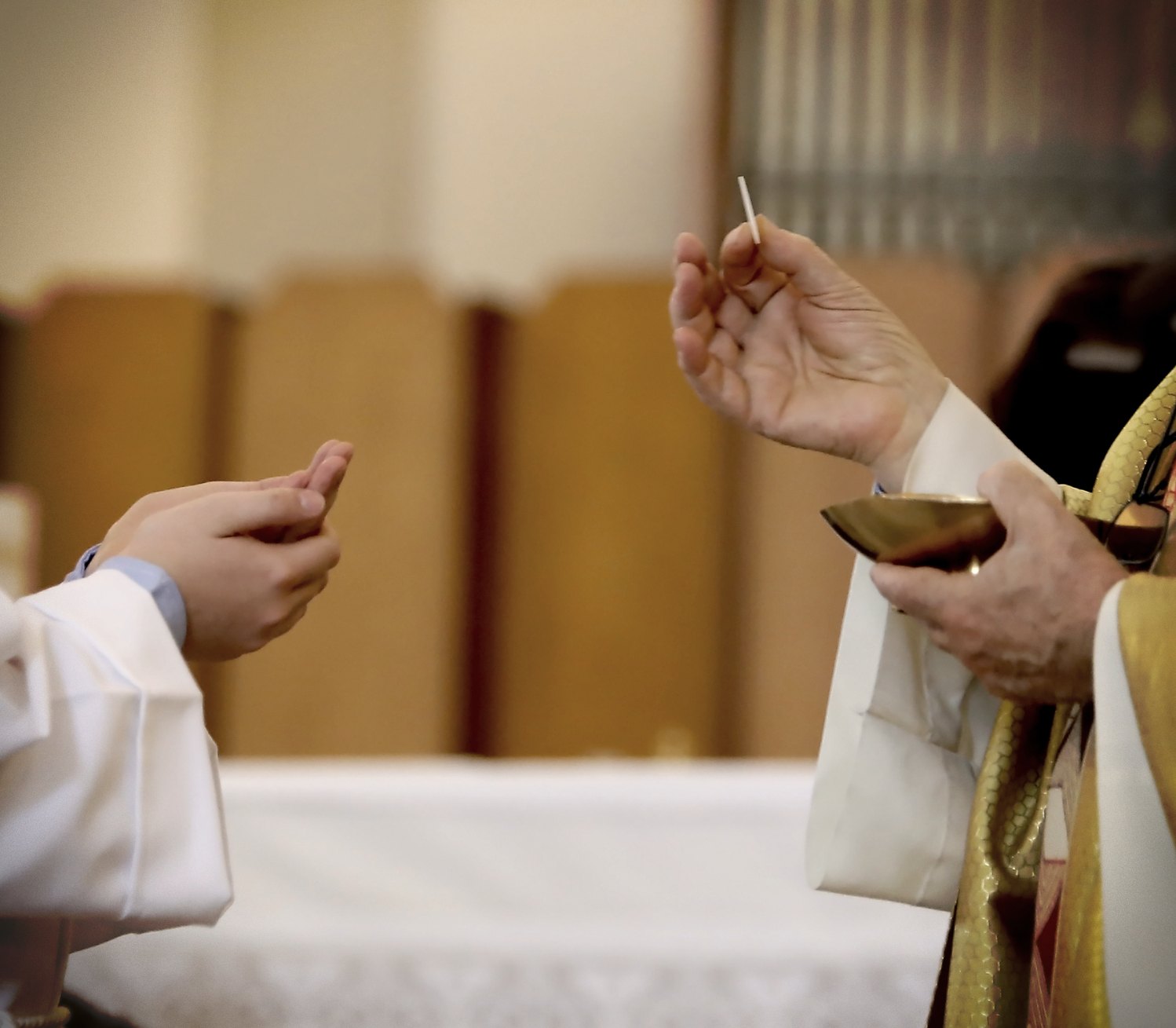
SAINT Faustina recounts how the Lord became unhappy with certain things taking place at her convent:
One day Jesus said to me, I am going to leave this house…. Because there are things here which displease Me. And the Host came out of the tabernacle and came to rest in my hands and I, with joy, placed it back in the tabernacle. This was repeated a second time, and I did the same thing. Despite this, it happened a third time, but the Host was transformed into the living Lord Jesus, who said to me, I will stay here no longer! At this, a powerful love for Jesus rose up in my soul, I answered, “And I, I will not let You leave this house, Jesus!” And again Jesus disappeared while the Host remained in my hands. Once again I put it back in the chalice and closed it up in the tabernacle. And Jesus stayed with us. I undertook to make three days of adoration by way of reparation. —Divine Mercy in My Soul, Diary, n. 44
 Another time, St. Faustina attended Mass with the intention of making reparation for offences against God. She wrote:
Another time, St. Faustina attended Mass with the intention of making reparation for offences against God. She wrote:
It was my duty to make amends to the Lord for all offenses and acts of disrespect and to pray that, on this day, no sacrilege be committed. This day, my spirit was set aflame with special love for the Eucharist. It seemed to me that I was transformed into a blazing fire. When I was about to receive Holy Communion, a second Host fell onto the priest’s sleeve, and I did not know which host I was to receive. After I had hesitated for a moment, the priest made an impatient gesture with his hand to tell me I should receive the host. When I took the Host he gave me, the other one fell onto my hands. The priest went along the altar rail to distribute Communion, and I held the Lord Jesus in my hands all that time. When the priest approached me again, I raised the Host for him to put it back into the chalice, because when I had first received Jesus I could not speak before consuming the Host, and so could not tell him that the other had fallen. But while I was holding the Host in my hand, I felt such a power of love that for the rest of the day I could neither eat nor come to my senses. I heard these words from the Host: I desired to rest in your hands, not only in your heart. And at that moment I saw the little Jesus. But when the priest approached, I saw once again only the Host. —Divine Mercy in My Soul, Diary, n. 160
Before I comment on the above, let me repeat for those who have not read Part I here. The guidelines of the Church are clear: the normative practice for Catholics all over the world is for them to receive the Holy Eucharist on the tongue. Second, this is how I have received Jesus for years, and will continue to do so as long as I possibly can. Third, if I were pope (and thank God I am not), I would ask every parish in the world to reinstall a humble Communion rail that would allow parishioners to receive the Blessed Sacrament in a way proper to Who it is that they are receiving: kneeling (for those who can) and on the tongue. As the saying goes: lex orandi, lex credendi: “the law of prayer is the law of belief”. In other words, the way we worship ought to be in accord with what we believe. Hence, this is the reason that Catholic art, architecture, sacred music, the manner of our reverence, and all the ornaments of the Liturgy that have grown throughout the centuries became, in themselves, a mystical language that spoke without words. No wonder, then, that Satan attacked much of this in the past fifty years in order to silence the divine (see On Weaponizing the Mass).
TOUCHING JESUS
That said, we can also infer much from St. Faustina’s accounts. First, while the Lord was displeased with certain things in the nun’s home, one of them was evidently not the idea of being in the hands of someone who loved Him. He, in fact, insisted three times on being in her unconsecrated (ie. not sacramentally ordained) hands. Second, at the very Mass where St. Faustina is making reparation for “all offenses and acts of disrespect”, the Lord is not offended to have touched her hands. In fact, He “desired” it. Now, none of this is to say that Jesus was indicating a preferred change in the liturgical practice of the day (Communion on the tongue), but that Our Eucharistic Lord, simply, “rests” with the one who reverently loves Him, and yes, even in their hands.
To those who are appalled by these accounts, I would also turn your attention to Sacred Scripture where Jesus appears to the Twelve after His Resurrection. While still in a state of doubt, Jesus invites Thomas to place his fingers into  His side, the very place where the Blood and Water gushed forth (symbolic of the Sacraments).
His side, the very place where the Blood and Water gushed forth (symbolic of the Sacraments).
Then he said to Thomas, “Put your finger here, and see my hands; and put out your hand, and place it in my side; do not be faithless, but believing.” (John 20:27)
And then there was a woman “who was a sinner” who entered the house where Jesus was. She…
…brought an alabaster flask of ointment, and standing behind him at his feet, weeping, she began to wet his feet with her tears, and wiped them with the hair of her head, and kissed his feet, and anointed them with the ointment. (Luke 7:39)
The Pharisees were disgusted. “If this man were a prophet, he would have known who and what sort of woman this is who is touching him, for she is a sinner.”[1]v. 39
Likewise, many people “were bringing children to him, that he might touch them,” and the disciples became “indignant.” But Jesus replied:
Let the children come to me, do not hinder them; for to such belongs the kingdom of God. (Mark 10:14)
All this is to say that the liturgical practice of receiving Jesus on the tongue is taught, not because Our Lord does not want to touch us, but so that we remember Who it is that we are touching.
ANSWERING YOUR LETTERS
I wish to reiterate the point of this series on Communion in the hand: to answer your questions as to whether it is immoral or unlawful to receive the Holy Eucharist in your hands where dioceses are now making this a requirement due to COVID-19.
Setting aside the positive comments from both priests and laity after reading Part I, others felt that I was somehow making “light” of Communion in the hand. Some have insisted that they will refuse the Eucharist anyway and instead make a “Spiritual Communion.” Others tried to dismiss the Catechetical Lectures of St. Cyril as possibly not his words or really not indicative of ancient practices.
The fact is that there is little written about the practice of how the Eucharist was received in early times. But what scholars unanimously agree upon is that the Last Supper would have been a typical Jewish Seder meal, with the  exception of Jesus not partaking in the “fourth cup”.[2]cf. “Hunt for the Fourth Cup”, Dr. Scott Hahn This is to say that the Lord would have broken the unleavened bread and distributed it in normal fashion—each Apostle taking the Bread into his hands and consuming it. Hence, this would have most likely been the practice of the first Christians for some time.
exception of Jesus not partaking in the “fourth cup”.[2]cf. “Hunt for the Fourth Cup”, Dr. Scott Hahn This is to say that the Lord would have broken the unleavened bread and distributed it in normal fashion—each Apostle taking the Bread into his hands and consuming it. Hence, this would have most likely been the practice of the first Christians for some time.
The first Christians were all Jewish and they continued to celebrate the Passover once a year for many years, at least until the Temple at Jerusalem was destroyed in around 70 AD. —Marg Mowczko, MA in early Christian and Jewish studies; cf. “The Passover Meal, the Seder, and the Eucharist”
In fact, we know for certain that for at least the first three to four centuries, Christians in various ways received the Eucharist on the palm of their hand.
In the Early Church, the faithful, before receiving the consecrated Bread, had to wash the palms of their hands. —Bishop Athanasius Scheider, Dominus Est, pg. 29
St. Athanasius (298–373), St. Cyprian (210–258), St. John Chrysostom (349–407), and Theodore of Mopsuestia (350–428) can all attest to the practice of Communion in the hand. St. Athanasius refers to the washing of the hands before receiving. St. Cyprian, St. John Chrysostom, and Theodore of Mopsuestia mention similar things such as receiving in the right hand then adoring Him and kissing Him. —André Levesque, “Hand or Tongue: The Eucharistic Reception Debate”
One of the more striking testimonies around the same period as St. Cyrus came from St. Basil the Great. And as I will explain in a moment, it applies especially to times of persecution.
It is good and beneficial to communicate every day, and to partake of the holy body and blood of Christ. For He distinctly says, He that eats my flesh and drinks my blood has eternal life… It is needless to point out that for anyone in times of persecution to be compelled to take the communion in his own hand, without the presence of a priest or minister, is not a serious offense, as long custom sanctions this practice from the facts themselves. All the solitaries in the desert, where there is no priest, take the communion themselves, keeping communion at home. And at Alexandria and in Egypt, each one of the laity, for the most part, keeps the communion, at his own house, and participates in it when he likes… And even in the church, when the priest gives the portion, the recipient takes it with complete power over it, and so lifts it to his lips with his own hand. —Letter 93
Of note, is that the Eucharist was taken home and that the laity, obviously, would have to handle the Host with their hands (it is presumed that all this was done with the greatest reverence and care). Second, Basil notes that “even in the church” this was the case. And third, during “times of persecution” especially he says, “it is not a serious offense” to receive in the hand. Well, we are living in times of persecution. For it is primarily the State and “science” that are imposing and demanding these restrictions, some of which seem baseless and contradictory.[3]Communion in the Hand? Pt. I
None of what I’ve just said is a flippant excuse to resort to receiving in the hand when you can still receive on the tongue. Rather it is to make two points. The first is that Communion in the hand is not an invention of the Calvinists, even if they later adopted this form in order to erode belief in the Real Presence.[4]Bishop Athanasius Schneider, Dominus Est, p. 37–38 Second, it is not your priest, nor your bishop, but the Holy See itself that has granted the indult for Communion in the hand. This is all to say that it is neither immoral nor unlawful to receive Communion in the hand. The pope remains sovereign on this matter, whether one approves or not.
SPIRITUAL COMMUNION?
Some have insisted that instead of Communion in the hand, I should be promoting “Spiritual Communion.” Moreover, some readers have said that their priests are telling them to do this.
Well, haven’t you heard that the Evangelicals are already doing this down the street? Yes, every Sunday there is an “altar call” and you can come to the front and spiritually invite Jesus into your heart. In fact, the Evangelicals might even say, “Plus, we have awesome music and powerful preachers.” (The irony is that some are insisting on not receiving in the hand in order to resist the “protestantization” of the Church).
Listen again to what Our Lord said: “My flesh is true food, and my blood is true drink.” [5]John 6:55 And then He said: “Take and eat.” [6]Matt 26:26 The command of Our Lord was not to gaze, to meditate, to wish, or to make a  “Spiritual Communion”—as beautiful as these are—but to eat. Hence, we should do as Our Lord commands in whatever way is devout and licit. While it has been years since I have received Jesus in my palm, whenever I did, it was as St. Cyril described. I bowed at the waist (where there was no Communion rail); I placed the “altar”of my palm forward, and with great love, devotion, and deliberation placed Jesus onto my tongue. Then, I examined my hand before stepping away to ensure that every particle of My Lord was consumed.
“Spiritual Communion”—as beautiful as these are—but to eat. Hence, we should do as Our Lord commands in whatever way is devout and licit. While it has been years since I have received Jesus in my palm, whenever I did, it was as St. Cyril described. I bowed at the waist (where there was no Communion rail); I placed the “altar”of my palm forward, and with great love, devotion, and deliberation placed Jesus onto my tongue. Then, I examined my hand before stepping away to ensure that every particle of My Lord was consumed.
For tell me, if any one gave you grains of gold, would you not hold them with all carefulness, being on your guard against losing any of them, and suffering loss? Will you not then much more carefully keep watch, that not a crumb fall from you of what is more precious than gold and precious stones? —St. Cyril of Jerusalem, 4th century; Catechetical Lecture 23, n. 21
I confess that I am personally struggling with the knowledge that some priests would deprive their flocks of the Eucharist because the bishop has placed this “temporary” form of receiving in the hand. As Ezekiel lamented:
Woe, shepherds of Israel who have been feeding yourselves! Should not shepherds feed the sheep? You eat the fat, you clothe yourselves with the wool, you slaughter the fatlings; but you do not feed the sheep. The weak you have not strengthened, the sick you have not healed, the crippled you have not bound up, the strayed you have not brought back, the lost you have not sought, and with force and harshness you have ruled them. (Ezekiel 34:2-4)
It is not liberalism being addressed here but legalism. One priest wrote me a few moments ago, noting:
It’s coming to the point that the mouth area is of particular concern for transmission [of the coronavirus]… The bishops are considering this very carefully… People have to ask themselves: are they going to insist that reverence for Jesus be expressed by receiving on the tongue—an ancient practice—or on the altar formed by the hands—also an ancient practice. The question is how does Jesus want to give himself to them, not how do they insist on receiving Him. We must never be the boss of Jesus who longs to fill us with His presence.
In that light, here is another consideration. Perhaps the indult allowing Communion on the hand, granted some fifty years ago by the pope, may be the Lord’s provision precisely for these days so that He could continue to feed His flock when the government, otherwise, might ban the Eucharist altogether if “on the tongue” were insisted upon?
Thus says the Lord God, “Behold… no longer shall the shepherds feed themselves. I will rescue my sheep from their mouths, that they may not be food for them.” (Ezekiel 34:10)
God can and does make all things work to the good. But some of you have said, “Ah, but the abuses in the hand! The sacrileges!”
THE SACRILEGES
Yes, there is no question that the Eucharist has been desecrated countless times through Communion “in the hand.” And here, I am not only talking about satanists walking away with it but the average Catholic casually receiving the Host without regard or even belief in what they’re doing. But let us also speak, then, of another tragedy: the colossal failure of catechesis in our times. Few are the homilies on the Real Presence much less how to receive, how to dress at Mass, etc. So when Catholics arrive in beach clothes and saunter up to the aisle with chewing gum in their mouths, who is to blame?
 Moreover, some of the genuine pain many of you are feeling right now could be alleviated by pastors not only announcing new rules but explaining, with tenderness and understanding, the difficulties this presents; by explaining the Holy See’s indult and then how to receive properly on the hand where the bishop has imposed this form. We’re a family and a little communication goes a long way.
Moreover, some of the genuine pain many of you are feeling right now could be alleviated by pastors not only announcing new rules but explaining, with tenderness and understanding, the difficulties this presents; by explaining the Holy See’s indult and then how to receive properly on the hand where the bishop has imposed this form. We’re a family and a little communication goes a long way.
Back in the 1970’s, the Japanese visionary Sr. Agnes Sasagawa felt the painful stigmata in her left hand, which prevented her from receiving Communion that way. She felt it was a sign that she was to receive on the tongue. Her whole convent returned to that practice as a result. Fr. Joseph Marie Jacque of the Paris Foreign Mission Society was one of the eye-witnesses (to the miraculous tears of the statue of Our Lady) and a theologian who came to know deeply about the spiritual condition of the nuns at Akita. “Regarding this occurrence,” Fr. Joseph concluded, “the episode on July 26th shows us that God wants lay people and nuns to receive Communion on the tongue, because Communion by their unconsecrated hands carries with it the potential danger of hurting and undermining faith in the Real Presence.”[7]Akita, by Francis Mutsuo Fukushima
Since the Holy See has permitted Communion in the hand, pastors can avoid “the potential danger of hurting and undermining faith in the Real Presence” by using this moment to re-catechize the faithful on the Holy Eucharist and how to receive Jesus with proper reverence. Second, the faithful can use this opportunity to discuss the contents of this series and reconsider, renew, and revive your devotion toward the Blessed Sacrament.
And last, may we all consider this. As baptized Christians, said St. Paul, “your body is a temple of the Holy Spirit” [8]1 Cor 6:19 — and that includes your hands and your tongue. The truth is that far more people use their hands to build, caress, love and serve than their tongues, which often tear down, ridicule, cuss and judge.
Whichever altar you receive your Lord upon… may it be a fitting one.
RELATED READING
Communion in the Hand? – Part I
To journey with Mark in The Now Word,
click on the banner below to subscribe.
Your email will not be shared with anyone.
Footnotes
| ↑1 | v. 39 |
|---|---|
| ↑2 | cf. “Hunt for the Fourth Cup”, Dr. Scott Hahn |
| ↑3 | Communion in the Hand? Pt. I |
| ↑4 | Bishop Athanasius Schneider, Dominus Est, p. 37–38 |
| ↑5 | John 6:55 |
| ↑6 | Matt 26:26 |
| ↑7 | Akita, by Francis Mutsuo Fukushima |
| ↑8 | 1 Cor 6:19 |



